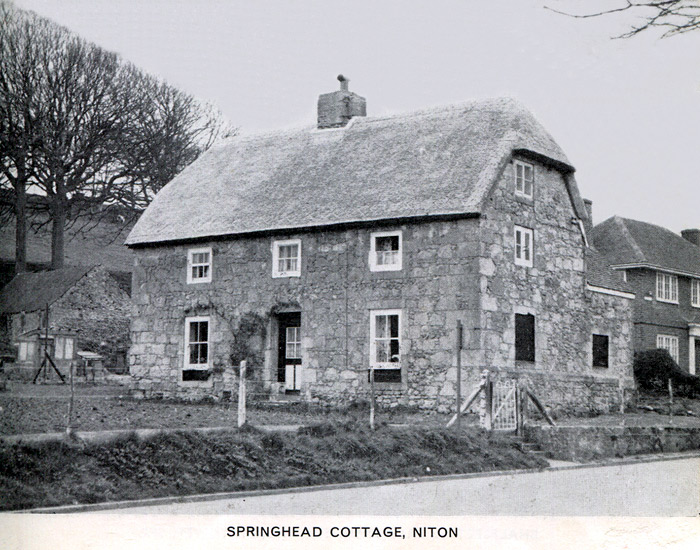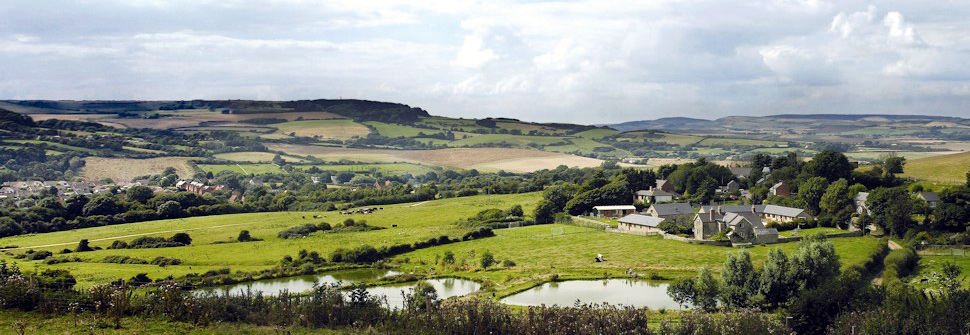Niton
Niton is a twin village, one part lying in a hollow of the Downs, and the other facing the sea along the great natural terrace of the Undercliff. Held from the Confessor by two freemen, the nucleus of the village seems to have consisted of the Church, the Manor Farm (there was never a true manor-house), the village green, and a number of houses which were built along the natural approaches from the Downs and spread down the valley beside the river Yar, which, rising in one of the manor fields, used to flow through the village as an open stream, miniature stone bridges spanning it for access to the houses. The Star Inn (certainly built before 1615, and now, sadly, closed) the Old Cottage adjoining it, and a farmhouse called Herveys (earlier than 1750) probably replaced buildings of the first Niton. A beam in the manor farmhouse bears the date 1415, and one in Springhead Cottages 1412.
The old tracks gradually became lanes; Chalton Lane to the west (now the main road to Chale), Munt's Lane to the north (now the Newport road), Cow Lane, which was used for moving cattle down to the eastern pastures, and is now the road to whitwell, and what seems to have been an indifferent way south to the Undercliff, but is now the busiest main road.

The Church was one of the six given to the Abbey of Lyra in Normandy. The nave was built in the 11 th century on an older foundation, and the aisles and tower over a period of about 300 years. The original dedication was to St. Michael, but for some unknown reason it was later changed to St. John the Baptist. After the Dissolution the Church reverted to the Crown, and the advowson was given by Charles I, at the request of his Queen, to Queen's College, Oxford, by whom it is still held.
On the village green (now the churchyard) stood a large stone base of four steps surmounted by a cross called the Playe Cross; on these steps contracts were signed, and declarations made, and a fish market was held there; the original base remains, but the cross is modern.
The Registers, commencing in 1559, contain many interesting details. In 1675 the Rev. Collinson proudly recalls that Charles II, landing at Puckaster "after enduring a great and dangerous storm at sea", was entertained for two nights at the Rectory; and in 1840 the first lighting of St. Catherine's Lighthouse is described by the Rev.P.Hoskins.
In the Undercliff were a number of small farms, one of which was Buddle Farm, now widely known as the Buddle Inn; the name means simply a homestead.
Fishing was one of the means of livelihood, and in the 17th and 18th centuries Niton was so renowned for the excellence of the crabs caught there that it was often referred to as Crab Niton.
In the late 1700s the Undercliff began to be popular as a health resort, or summer residence, and a number of cottages were converted to "gentlemen's seats" ; other houses were built and beautiful gardens laid out, providing new sources of employment. The roads were much improved, the old pack-horse trail over the cliff to Chale being replaced by the road at its foot leading to Blackgang, and the track up into the upper village opened into a road through "a remarkable depression in the barrier of the cliff".
The coast was extremely dangerous, many wrecks occurring around St. Catherine's Point. One of these was the French ship Russie, part of her cargo being wines and spirits, much of which floated ashore. Such a chance was obviously not to be missed, but the "tasters" found the wine rather strong, and many were soon lying about the beach in a state of happy oblivion. A lurid description of this painful scene, with extremely impolite comments on the manners and morals of the people of Niton, appeared in a French newspaper, garnished with highly-coloured illustrations!
Smuggling was looked upon as a normal occupation, and it was not until the gangs began to terrorise people – committing at least one murder – that public opinion began to turn against it. Eventually the interception of a large "run" at Puckaster, and the subsequent prosecutions and very heavy fines, brought the trade to an end locally.
St. Catherine's was one of the sites used by Signor Marconi for his experiments, and he spent some time at the Sandrock Hotel. The famous mast which he used was so long that walls had to be pulled down to get it round the corners on the way to the Lighthouse.
The gault clay, locally known as Blue Slipper, is the cause of many landslips in the Undercliff. In 1928 the beautiful road to Blackgang was destroyed by an immense cliff fall, followed by the collapse of a large area of ground, which slid down into the sea near St. Catherine's. It was found impossible to reconstruct the road, so a new one was built from upper Niton over the southern end of St. Catherine's Down.
Niton had its share of war-time alarms, and was the scene of the last local air-raid, in 1943, which caused damage and casualties in parts of the village. The three Lighthouse keepers were all killed, and the light was out of action for some time.
The district has a wonderful selection of footpaths and bridleways, and the view from the crest of the inland cliff is superb. The whole area is of immense interest to naturalists, and the badger family which lives in Boxer's Lane has been filmed and photographed times without number.
Now development has reached out to the old village, and there are council houses, housing estates and other building, but fortunately so far without detracting too much from the beauty of the countryside; and the newcomers are very welcome as the majority take an active interest in the life of the village.

